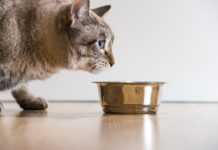Poor Prognosis: Restrictive Cardiomyopathy
A recent study out of Italy looked at survival and prognostic factors for cats with restrictive cardiomyopathy. The researchers looked at 90 cats who had been diagnosed with this cardiac condition via echocardiography between 1997 and 2015. There were 53 more males than females in the study.
Happening Now…
Angelos Pizza in Matawan, N.J., is delivering more than just food, according to CBS NewYork Channel 2.
Cats Prefer to Work for Their Food
In January, we wrote about the recent American Veterinary Medical Association (AVMA) updated guidelines on feeding cats to make feeding programs more natural, emphasizing a cats natural desire to hunt. Hunting keeps the cat active, which burns calories and promotes a healthy body weight and lean muscle mass. These five things will help you make feeding time more like a hunt.
Happening now
A 45-year-old Singapore man was arrested for trying to smuggle four kittens past immigration, according to Channel NewsAsia. Security noticed the mans pants were meowing. He faces a possible fine and one year in prison.
Normal vs Excessive Shedding
Shedding is a normal part of life for mammals-old hairs fall out, allowing new hair to grow in. Animals shed year-round with typically two heavy periods in spring and fall-building up and getting rid of a winter coat, says William Miller, VMD, DACVD, Dermatology Section Chief at the Cornell University School of Veterinary Medicine. During these times of the year, it may seem like there is more hair on the floor than on the cat.
Bloodwork for Liver Problems
Liver (hepatic) diseases are common in cats, especially seniors. While clinical signs and symptoms are important (is your cat drinking more than usual or not eating?), bloodwork is the backbone of diagnosis. Usually, this will be several tests grouped as a small-animal liver (hepatic) function panel.
Feline Pancreatitis May Be Chronic
When pet owners think of pancreatitis, often the image that comes to mind is a dog who does a garbage raid and consumes a bunch of spoiled or fatty food. Dietary indiscretion usually is not considered a cause of pancreatitis in cats, perhaps because cats are more fastidious in their eating habits!
FDA Approves Revolution Plus
The U.S. Food and Drug Administration (FDA) has approved Revolution Plus (selamectin and sarolaner topical solution), a new combination topical product that provides protection against fleas, ticks, ear mites, roundworms, hookworms, and heartworms for cats and kittens as young as eight weeks of age and weighing 2.8 pounds or greater. Revolution Plus combines the proven broad-spectrum protection of selamectin (found in Revolution) with the advanced flea- and tick-killing power of sarolaner.
Soothing the Savage Beast
Many family cats show signs of stress at some point. It may be a short-term stress, which is a swiftly passing stage that may occur after a move or the addition of a new pet. But some cats show long-term stress. Stress may manifest itself as urinary marking, aggression toward people or other pets, scratching inappropriate things like furniture, or overzealous grooming leading to hair loss and possible skin lesions. Some physical ailments, such as idiopathic cystitis and chronic gastrointestinal problems, can also be stress-related.
Kids Bored This Winter?
The American Veterinary Medical Association has a downloadable PDF called Owning a Pet: A Job for the Whole Family.
Dolasetron Fails for Vomiting in Felines
Dolasetron (brand name Anzemet) has been used in people to help with chemotherapy-induced nausea. It inhibits vomiting and nausea via pathways in both the gastrointestnal tract and the central nervous system. This dual action made it sound helpful to cats, thought researchers in California. Their study was reported in the August 2018 Journal of Feline Medicine and Surgery.
New Feeding Guidelines Address Behavior
The American Association of Feline Practitioners (AAFP) recently released a consensus statement called Feline Feeding Programs: Addressing Behavioral Needs to Improve Feline Health and Wellbeing to address medical, social, and emotional problems that can result from the manner in which most cats are currently fed. It was published in the Journal of Feline Medicine and Surgery and transformed into a handout for cat owners.

















